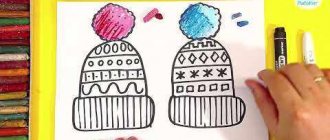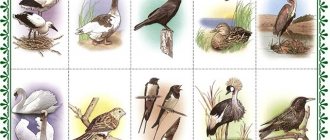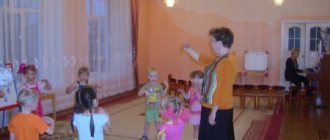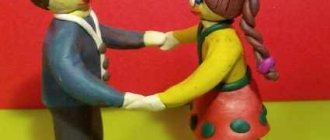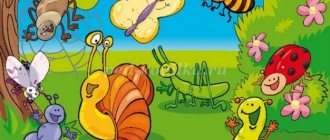Preview:
Municipal state preschool educational institution kindergarten No. 5 “Rodnichok”
Peskovka village, Omutninsky district
Summary of a lesson on artistic design with children of senior preschool age
Author - Tarasova Galina Petrovna,
teacher of the highest qualification category.
Contact phone: 88335236753
Summary of a lesson on artistic and decorative design in a preparatory school group.
Theme: “House is a flower” (spatial - decorative design)
Objectives: 1. Teach children to create jewelry from their chosen artistic material. 2.Develop the ability to decorate products. 3. Develop imagination, aesthetic taste, accuracy. 4. Develop coherent speech, using the text of a fairy tale as a model.
Material: Illustration material “Flowers”
Cardboard box, gouache, felt-tip pens, pencil, brushes, wax crayons, PVA glue, napkins, polystyrene foam, pieces of fabric, sequins, beads, natural materials, colored paper. CD “Magic Sounds of Nature”
Preliminary work: Making attributes for the dance composition “Flowers”. Making the cone theater “Thumbelina”. Labor in nature: caring for flowers. A story about useful and dangerous flowers. Reading a fairy tale by G.Kh. Andersen "Thumbelina"
The buzzing of insects can be heard in the group. (CD “Magic Sounds of Nature”), the teacher invites the children to go around the room and find the source of the sound. Characters from the fairy tale “Thumbelina” are found in a pot with an indoor flower.
The teacher reads excerpts from this fairy tale:
There lived one woman in the world. She didn't have children, but she really wanted a baby. So she went to the old witch and said:
“I really want to have a daughter, even the smallest one.”
- What’s easier! - answered the witch. - Here's some barley grain for you. This grain is not simple, not the kind that ripens in your fields and is born as food for birds. Take it and plant it in a flower pot. You'll see what happens. - Thank you! - said the woman and gave the witch twelve coppers. Then she went home and planted a grain of barley in a flower pot. As soon as she watered it, the seed immediately sprouted. Two leaves and a tender stem appeared from the ground. And on the stem a large wonderful flower appeared, like a tulip. But the flower's petals were tightly compressed: it had not yet bloomed.
- What a lovely flower! – the woman said and kissed the beautiful colorful petals. At that very moment, something clicked in the core of the flower, and it opened. It was, in fact, a large tulip, but in its cup sat a living girl. She was tiny, tiny, only an inch tall. That's why they called her that - Thumbelina...
The teacher invites the children to independently remember the content of the work. Sample stories from children: Thumbelina is a tiny girl who goes through many trials. She escapes from the frog, but falls straight into the clutches of the cockchafer, who soon abandons her and the poor girl is left alone in the forest. Thumbelina has a kind heart, because she saves herself and also saves the swallow, who takes her to warmer climes to a flower, where the baby meets the king of the elves.
Holding fairy tale characters in their palms, children act out fairy tale dialogues. Motivation: But the fairytale guests are in a bad mood, they have nowhere to live. The children offer to make a home for the heroes, and they will stay with them in the group.
The teacher creates a problematic situation: what can we make housing from so that it is comfortable, separate, beautiful, and functional?
Children disperse into groups, find objects suitable for guests to live in and explain their choice.
The teacher suggests that the most ordinary cardboard box is suitable for this. It can be designed in the form of a flowering meadow, and voluminous flowers will serve as a home. Children look at pictures of flowers, choose the most beautiful and comfortable flower to live in (a dense bud, tall and wide petals, a lot of pollen for a feather bed, etc.)
The teacher and children jointly create a collective sketch of the scene - background (gouache, felt-tip pens, crayons)
Children are divided into groups and distribute the work themselves (background, grass, pebbles, small volumetric flowers, a palace in the form of a large volumetric flower).
Together with the teacher, they recall the technology of making flowers from paper (origami), grass, stones, leaves (3-dimensional applique)
After completing the main work, decorate with additional artistic material.
The teacher invites you to admire the beauty and fabulousness of the work performed. Children help fairy-tale characters “choose and move into” ready-made houses—flowers. They organize a “Ball among Flowers”.
Bibliography.
- G. H. Andersen fairy tale “Thumbelina”
- Z.V. Bogateev “Wonderful paper crafts” publishing house “Prosveshcheniye” 1992
- I.A. Lykova “Visual activities in kindergarten”, publishing house “Sfera”, 2007.
- G.N. Panteleev “Children’s Design” publishing house “Karapuz” 2006
- THEM. Petrova “Applique for preschoolers” publishing house “CHILDHOOD - PRESS” 2007
Outline of a lesson on children's design in the senior group
"Decoupage"
- generalize children’s understanding of design and its varieties;
- introduce the decoupage technique;
- consolidate the ability to apply glue with intermittent strokes;
- develop creative imagination;
- cultivate accuracy while working.
- artistic word;
- explanation;
- slide presentation demonstration;
- showing the method of action;
- exhibition of creative works;
- interviewing children.
MATERIALS AND EQUIPMENT:
kitchen utensils, three-layer napkins, glue, brush holders, brushes, scissors, tape recorder, flash drive.
Educator:
“One day, a tea set that stood in the window of the Gifts store started a conversation:
“I’m the most beautiful, everyone admires me, they admire me, and soon they’ll buy me.”
“But we are also beautiful and pleasing to the eye,” answered the porcelain dolls.
“Look at us, we are always the center of attention,” protested the vases.
A scandal broke out in the store, and all the “gifts” were noisy, arguing, and nervous. The shelf could not withstand the stress, and all the goods fell and broke.”
Educator:
"What to do? There are paints, glue, dolls and vases, but who can fix everything, what wizard will restore the “gifts” and make each of them unique?” (Children's answers).
— People who paint dishes, come up with unusual houses, decorate shop windows, decorate fountains, i.e. design specialists, are called designers. They create new items that are not only beautiful, but also durable, reliable and comfortable.
Slide presentation (Design. Varieties)
— Among the many options for designing objects, there is also the “decoupage” technique. This is decoration based on attaching a design to an object. Today we will use this technique to decorate items used in the kitchen using a three-layer napkin.
— For work we will need: three-layer napkins, glue, brushes, items used in the kitchen, scissors. Select a design on a napkin, separate the first layer by tearing it off or using scissors, cut out the design, apply it to a plate and carefully spread it from the middle with a brush with glue. When the plate is thoroughly dry, it can be varnished for durability.
Here is a large glass teapot, “inflate” your belly, one hand on your belt,
SUMMARY OF NODE CHILDREN'S DESIGN
SUMMARY OF NODE CHILDREN'S DESIGN
Senior group.
Objectives: 1. To develop emotional responsiveness in children, to encourage them to create the image of a festive dress.
2. Strengthen your skills in working with watercolors.
Learn to choose a color combination. Develop the skills of freely filling out the entire sheet (dress).
3.Continue to teach different brush techniques. Develop creativity and modeling abilities.
Material for GCD:
Sheets of white paper in the shape of a dress, watercolors, brushes, coasters, cups of water, napkins, “Paper Fairy”.
Progress of direct educational activities.
Educator: - Guys, today our guest is “The Paper Fairy”. She wants to give her goddaughter a gift - a beautiful dress. She wanted the dress to be modern and unique and, of course, beautiful. Do you think we can help her?
Children's answers.
I also think that we can do it if we apply all our knowledge and skills.
Remember, you and I looked at fashion magazines, went on an excursion to a clothing store, talked about how beautiful clothes are made, what professions people work on them.
Let's list them.
Children: - Fashion designers, designers, cutters, seamstresses.
Educator: Dresses are made from various materials, choosing colors and shades.
Now, you will try to offer the “Paper Fairy” your dresses, invented and drawn by you. And she will choose the best options for herself.
You can’t count all the flowers, how many of them there are in the world.
Well, guys, let’s imagine how we decorate the dress.
Let's choose a style and color, there are no better dresses than ours!
During the drawing process, individual work is carried out to clarify the concept, advice is given on the use of colors and shades, and mixing paints.
Mark drawings that are ready and close to completion.
Lay out the drawings on the table and admire them. Invite children to evaluate their work and the work of their friends. Mark the most successful ones, tactfully, without offending others.
The “Paper Fairy” (represented by the teacher’s assistant) examines the dresses, chooses the dresses she likes, and praises all the children. Promises to use all models in the future.
“Paper Fairy”: Wonderful dresses, my eyes wide open.
I want to try everything on and say thank you to everyone!
You draw them more often, and I will fly in,
Choose your dresses for yourself and for your girlfriends.
In the meantime, I’ll take this and give it to my goddaughter.
Thank you, wonderful designers, for everything!
Educator: Well, guys, you did a very good job. We will place your works on the stand, let everyone admire them, maybe someone else will choose a suitable outfit for themselves. Thanks to all. We are cleaning our workplaces.
